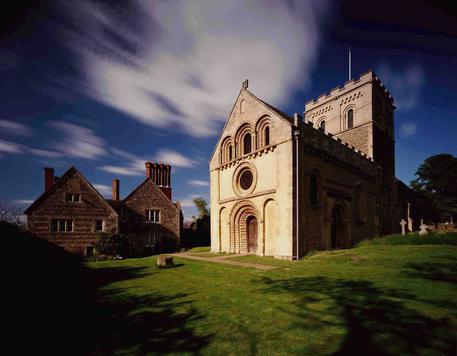
Photograph copyright ©1999 - 2018 Denis Waugh.
External Links
IFFLEY
At Osney Lock in high summer the scene is of jigsaw-box perfection, with limpid green water and prematurely grey baby coots babies shrilly demanding food indiscriminately from parents and siblings. Here the freshwater Olympics are in full swing. A minnow leaps five times from the water in a straight line, like a skipping stone. The fishermen, though, on this warm August afternoon, are despondent. `Not a bite all day,' complains a hefty bronzed yoof, tattooed chest bursting from black singlet, blue-emblazoned with the inspiring legend `Fuck off'. A coarse fisherman, no doubt. As he packs up, a nonchalant tern dives, brings up a five-inch shimmer of silver and proceeds to parade it up and down the river. It's easy, really.
The chunky little Church of St Mary the Virgin at Iffley is pure Norman - quite possibly the finest remaining example of a Norman church in England. The six-foot groove for the massive wooden bar used to secure the church against attackers seems something of an anomaly in this most gentle of Oxford suburbs, a favourite Sunday lunchtime stroll or punt for undergraduates. In 1940 one of them wrote:
What sudden fearful fate
can deter my shade wandering next year
from a return? Whistle and I will hear
and come another evening, when this boat
travels with you alone towards Iffley
as you lie looking up for thunder again
this cool touch does not betoken rain
it is my spirit that kisses your mouth lightly.
In March, 1944 he wrote:
Everyone, I suppose, will use these minutes
to look back, to hear music and recall
what we were doing and saying that year
during our last few months as people, near
the sucking mouth of the day that swallowed us all
into the stomach of a war...
Which was, of course, the answer. And Keith Douglas, knowing it and having thus arranged his life's work ready for publication, died that year in Normandy aged 24.
Some historians say the church was built in the time of Henry II, others during the reign of one of his recalcitrant sons, Richard or John. The appearance of Henry, supposedly the instigator of Becket's murder, amongst the monsters on the south doorway is quoted as evidence. Possibly. What is certain is that the chevron patterns and the hundred-odd beak-heads on the door arches, the likenesses of the evangelists, and the numerous stone carvings of animals and birds both within and without this glorious building cannot fail to move the heart of even the most churlish of visitors.
In 1207 King John, not the most equable of men, quarrelled with one of his staunchest supporters, William de Braose. He outlawed William and imprisoned his wife and their eldest son in Windsor Castle, where they were left to starve to death. A daughter, Annora, later became an anchoress here at Iffley, living in a cell attached to the church. The blocked up arch in the east end of the south wall may signify the presence of a window through which she could see the altar. Henry III, John's son, and noted for piety rather than wise government, was clearly ashamed of his father's cruelty and made gifts to Annora of grain and clothing as well as firewood and building timber from his forests.
A couple in the churchyard have arrived just too late to gain admittance. `I was baptized here in 1929,' says the wife. `Then we moved. I would have liked to see it.'
`You must see it,' I insist. I cannot bear that someone with a piece of personal history invested in this remarkable building should give up because I, too, have found a link with this church. The father of a New Zealand soldier killed in the Great War funded a plaque here for his son. My cousin was to marry his granddaughter. When so unexpectedly reminded that we are not just bystanders but a part of it all, we can perhaps be forgiven for assuming such a proprietorial air.
Text copyright ©1999 - 2018 Priscilla Waugh.